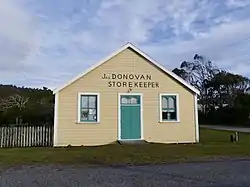| Donovan's Store | |
|---|---|
 Donovan's Store in 2020 | |
| General information | |
| Type | Commercial |
| Address | 17 The Strand |
| Town or city | Ōkārito |
| Country | New Zealand |
| Coordinates | 43°13′20.12″S 170°9′53.95″E / 43.2222556°S 170.1649861°E |
| Opened | c. 1866 |
| Technical details | |
| Material | Timber, corrugated iron |
| Designated | 28 June 1990 |
| Reference no. | 5008 |
Donovan's Store at Ōkārito on the West Coast of New Zealand is the oldest wooden building in Westland. It was built in the 1860s as a hotel and converted to a general store in the 1890s which operated for over 60 years. It is now a Category 1 listed historic place.
History
The Donovan's Store building was originally the Club Hotel, built on The Strand in 1865 or 1866 during the gold mining rush at Ōkārito.[1][2] The hotel was converted to a general store in the 1890s and run by James Donovan (1867–1960) and his wife Eva Donovan for about 60 years.[1][3] As well as the Ōkārito port the store serviced the gold dredge workers and flax cutters and Donovan was known for delivering supplies to isolated gold prospectors.[1][2] The store mainly sold foodstuffs but many household and other items were sold such as fabric and tools.[2]
Donovan ran the store until the 1950s, selling it to Keith (Robbie) Robertson of Whataroa who ran the store part–time until 1965.[2] In 1987 the building was bequeathed to the Historic Places Trust by Robertson. The Trust passed the building to the Department of Conservation (DOC) in 1988.[1][4] In 1990 the Trust gave the store a Category 1 listing, which designated it as a significant building meriting preservation.[1] It fell into disrepair but the local community decided in the 1990s to restore it to a usable building, with a library premises being one of the possible uses and in 1994 DOC began a five-year restoration programme.[4][5] The Ōkārito Community Association contributed $100,000 towards the renovation.[3] It owns and maintains the hall in partnership with DOC.[3]
In the 1990s the grounds surrounding the store were surveyed by botanist Elizabeth Woods who found roses, a holly tree, grapevine, oak tree and a mixture of other plants.[2]
In 2009, the governor-general, Anand Satyanand, visited the store while on the West Coast.[6]
Construction

The front part of the building is the oldest with a lean-to at the back added later. Reconstruction work on the store showed it was built with a mixture of native timbers including kauri, rimu, kahikatea and imported Baltic pine, the latter possibly scavenged from shipwrecks.[2] The sides and back of the building are clad in corrugated iron.
Current status
Since 1990 the building has been registered by Heritage New Zealand as a Category I structure, with registration number 5008.[7]
The building is now used as the Ōkārito Community Library with some of the book stock supplied by the Westland District Library.[4]
References
- 1 2 3 4 5 Cawley, Nancy (8 September 1993). "Okarito store's decay upsets Donovan family". The Press. p. 14.
- 1 2 3 4 5 6 McCormack Ross, Trish (13 May 1996). "Donovan's a window to rich past". The Press. p. 13.
- 1 2 3 "Great gigs for old digs". Conservation Action: 8. September 2010. Archived from the original on 12 October 2020. Retrieved 13 October 2020.
- 1 2 3 "From dancing girls to Donovan's store: the story of the Okarito Community Library". Library Life. 440: 8–9. November 2015. Archived from the original on 12 October 2020. Retrieved 13 October 2020.
- ↑ Attwood, Steve (January 1995). "Old Store". New Zealand Historic Places. 51: 39.
- ↑ "Donovan's Store". Governor General of New Zealand. 2009. Archived from the original on 12 March 2023. Retrieved 12 October 2020.
- ↑ "Donovan's Store". New Zealand Heritage List/Rārangi Kōrero. Heritage New Zealand. Retrieved 13 October 2020.
Further reading
- Bishop, Jane and Malcolm Walker. 1977. Westland Country: a centennial album 1876–1976. Pegasus Press. p. 156–157.